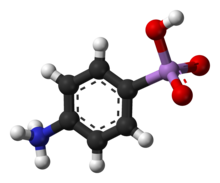
| |

| |
| Names | |
|---|---|
| Preferred IUPAC name
(4-Aminophenyl)arsonic acid | |
| Other names
4-Aminobenzenearsonic acid, 4-Aminophenylarsonic acid, 4-Arsanilic acid, Atoxyl
| |
| Identifiers | |
3D model (JSmol)
|
|
| 1102334 | |
| ChEBI | |
| ChEMBL | |
| ChemSpider | |
| DrugBank | |
| ECHA InfoCard | 100.002.432 |
| EC Number |
|
| 406354 | |
PubChem CID
|
|
| UNII | |
CompTox Dashboard (EPA)
|
|
| |
| |
| Properties | |
| C6H8AsNO3 | |
| Molar mass | 217.054 g/mol |
| Appearance | white solid |
| Density | 1.957 g/cm3 |
| Melting point | 232 °C (450 °F; 505 K) |
| modest | |
| Hazards | |
| Occupational safety and health (OHS/OSH): | |
Main hazards
|
Toxic |
| GHS labelling: | |
 
| |
| Danger | |
| H301, H331, H410 | |
| NFPA 704 (fire diamond) | |
| Related compounds | |
Related compounds
|
phenylarsonic acid |
Except where otherwise noted, data are given for materials in their standard state (at 25 °C [77 °F], 100 kPa).
| |
Arsanilic acid, also known as aminophenyl arsenic acid or aminophenyl arsonic acid, is an organoarsenic compound, an amino derivative of phenylarsonic acid whose amine group is in the 4-position. A crystalline powder introduced medically in the late 19th century as Atoxyl, its sodium salt was used by injection in the early 20th century as the first organic arsenical drug, but it was soon found prohibitively toxic for human use.[1]
Arsanilic acid saw long use as a veterinary feed additive promoting growth and to prevent or treat dysentery in poultry and swine.[2][3][4] In 2013, its approval by US government as an animal drug was voluntarily withdrawn by its sponsors.[5] Still sometimes used in laboratories,[6] arsanilic acid's legacy is principally through its influence on Paul Ehrlich in launching the antimicrobial chemotherapy approach to treating infectious diseases of humans.[7]
- ^ Burke ET (1925). "The arseno-therapy of syphilis; stovarsol, and tryparsamide". British Journal of Venereal Diseases. 1 (4): 321–38. doi:10.1136/sti.1.4.321. PMC 1046841. PMID 21772505.
- ^ National Research Council (US) Committee on Medical Biological Effects of Environmental Pollutants (1977). "Biological effects of arsenic on plants and animals: Domestic animals: Phenylarsonic feed additives". In Levander OA (ed.). Arsenic: Medical and Biological Effects of Environmental Pollutants. Washington DC: National Academies Press. pp. 149–51. doi:10.17226/9003. ISBN 978-0-309-02604-8. PMID 25101467.
- ^ Hanson LE, Carpenter LE, Aunan WJ, Ferrin EF (1955). "The use of arsanilic acid in the production of market pigs". Journal of Animal Science. 14 (2): 513–24. doi:10.2527/jas1955.142513x.[permanent dead link]
- ^ "Arsanilic acid—MIB #4". Canadian Food Inspection Agency. Sep 2006. Archived from the original on 2012-12-13. Retrieved 3 Aug 2012.
- ^ Cite error: The named reference
FDA2013was invoked but never defined (see the help page). - ^ Cite error: The named reference
Ahn-etalwas invoked but never defined (see the help page). - ^ Patrick J Collard, The Development of Microbiology (Cambridge, London, New York, Melbourne: Cambridge University Press, 1976), pp 53–4.
